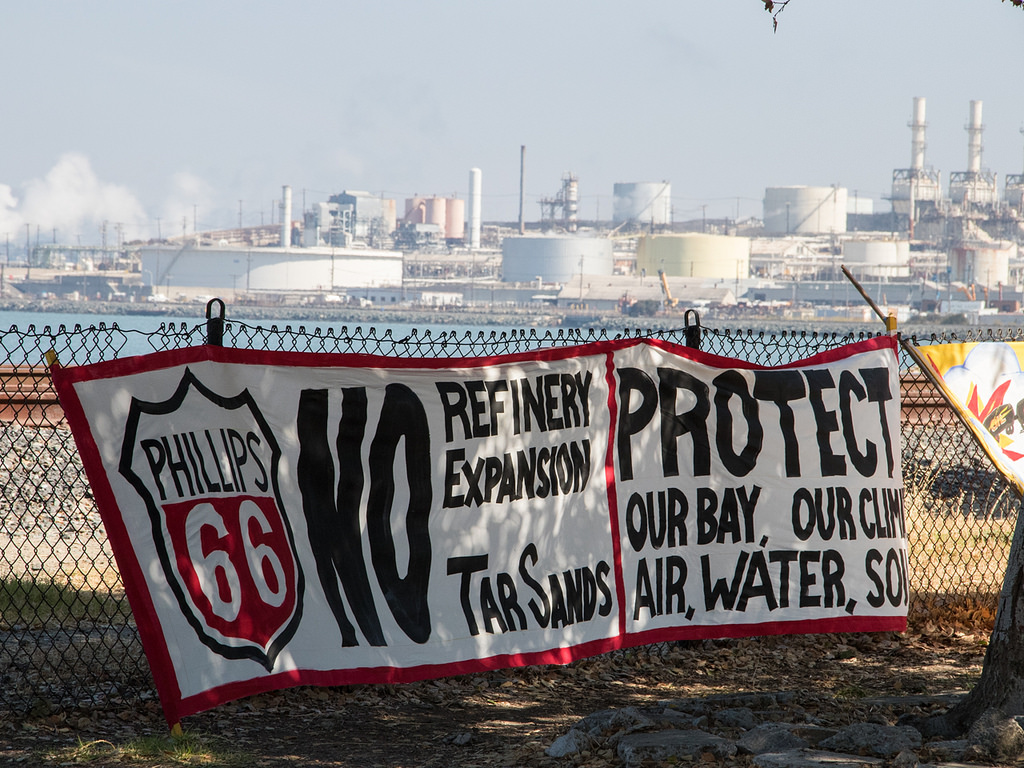By James Wilt, The Narwhal. Originally posted on The Narwhal.
Canadians might imagine Burnaby as the main site of protest against the Trans Mountain oil pipeline and tanker project, the Vancouver suburb marked as it is by dozens of peaceful demonstrations, arrests and associated court challenges in recent years.
But a new line of opposition is now being drawn on sandy beaches some 1,300 kilometres to the south — in the Bay Area of California. There, residents are increasingly concerned that the expansion of Trans Mountain may result in a major uptick in tankers carrying Alberta oilsands crude to the region’s five refineries, which comes with increased risks of spills, local air pollution, refinery accidents and a locking in of fossil fuel usage for decades to come.
Communities have specifically identified the proposed reconfiguration of the Phillips 66 Rodeo refinery near San Francisco to process more oilsands crude as a sign of things to come — and are already fighting back.
Contrary to the claims often made by government and industry, expanded oilsands production is far more likely to go to California than Asia: the state is much closer in proximity, sports the specialized refining capacity to process heavy oil and needs new imports to make up for dwindling domestic production.
“At a time when the whole world should be looking at strategies for a managed and just transition off fossil fuels, here we have big fossil fuel corporations like Phillips 66 spending resources to process more dangerous forms of crude like the Alberta tarsands,” said Pennie Opal Plant, co-founder of Idle No More SF Bay.
Recently, the local community and organizers were joined in Oakland, Calif., by members of the Tsleil-Waututh Nation, on whose traditional territory in the Burrard Inlet the Trans Mountain pipeline terminates. The Tsleil-Waututh were there to raise awareness about the controversial Canadian pipeline’s connection to refineries south of the border.
Not long after, a teach-in and prayer walk was held at the gates of the refinery.
“This is the first step in demanding that no tarsands are allowed to come through the Bay,” Opal Plant told The Narwhal.
“It’s communities up and down the state that have been stopping these projects,” said Greg Karras, senior scientist at the Richmond office of Communities for a Better Environment. “We’ve been batting like .900.”
Refinery Explosion Sent 15,000 Residents to Hospital
California isn’t currently importing much oilsands crude, if any at all. But it’s not for a lack of trying.
A bit of context: production from both the Alaska North Slope and central California oil fields has been declining in recent years, requiring increased imports from other countries.
Most has come from Saudi Arabia and Latin America.
In recent years, Phillips 66 (a spin off from ConocoPhillips) attempted to build an oil train terminal to bring about 50,000 barrels per day of oilsands crude to its San Francisco refinery. Three years of community opposition culminated in late 2017, when the county blocked the project from proceeding.
The region has experienced a series of major refinery-related incidents, helping to galvanize protest.
In August 2012, a massive explosion at Chevron’s refinery in nearby Richmond sent 15,000 people to the emergency room with respiratory issues. Matt Krogh, extreme oil campaign director at Stand.earth, told The Narwhal that the explosion was certified to be caused by sulfidation corrosion caused by high-sulphur crude (which may have included oilsands crude).
In September 2017, a corroded pipe at the Phillips 66 refinery spilled a barrel of gas oil, which itself followed a spill a year earlier during a tanker uploading that sent 100 people to hospital. Then, last month, a 25-acre fire started at Tesoro’s refinery, and had to be contained by Contra Costa County firefighters. Opal Plant of Idle No More noted that the Phillips 66 refinery is very close to a low-income community and across the street from a nursery school.
“People are increasingly aware of the expansion proposal for Phillips 66 and that it would involve tarsands,” Krogh said. “And they’re increasingly opposed and turning out to try to stop it.”
‘This is the sucking sound at the other end of the Trans Mountain’
There are two types of permits related to Phillips 66 — both of which residents are concerned about.
The first is a permit amendment from the local air district to triple the number of oil tankers that come through the bay, as well as the amount of crude they can take in via the wharf. The refinery is currently limited to 40,000 barrels per day from the wharf, and it wants to expand that to its a limit of 130,000 barrels per day. That would increase annual tanker traffic from 59 to 135 tankers.
“You have a massive increase in oil tanker traffic, likely carrying tarsands which regardless of what people in Alberta say is actually really hard to clean up,” said Krogh of Stand.earth.
There’s an ongoing bureaucratic squabble going on about that permit amendment, as it’s unclear if a land-use permit will be required from the county in addition to a permit from the air district. The confusion results from the fact the refinery is located in an unincorporated area under the county planning area. The first draft of the environmental impact report (California’s equivalent of an environmental assessment) is currently in a bit of a standstill because of this as well.
John Gioia, supervisor at Contra Costa County and member of the Bay Area Air Quality Management District, told The Narwhal that Phillips 66 recently appointed a new refinery manager and there hasn’t been any move to push the application to the point where a decision is made about the land-use permit issue.
But that could change quickly.
“The concern has been that if that project were built, it would increase the amount of crude that could come in over the wharf and therefore provide Phillips greater flexibility on where it obtains its crude for its refinery,” he said.
That’s where oilsands crude might come in. In mid-August, the air quality district issued a permit allowing for an increase of 4,000 barrels per day in hydrocracking capacity, required to break down heavy oil into usable fuels. That itself followed a 23,000 barrel per expansion of hydrocracking capacity in January, which prompted Idle No More SF Bay to start conducting actions at the air quality office.
It’s a process that Karras of Communities for a Better Environment described as “piecemealing.” He said in an interview with The Narwhal that hydrocracking is the bottleneck for expanding oil flow at the refinery, as it’s the only way that it can refine more oilsands crude into usable fuels.
“What they’ve told investors and what they’ve shown through the refinery changes they’re trying to make is they’re targeting diluted bitumen,” he said. “It’s very clear what this is about. This is the sucking sound at the other end of the Trans Mountain.”
Gioia warned against reading too much into the latest permit as the air district’s staff issued it based on a controversial decade-old approval that the board members are “still trying to understand.” However, he agreed that the expansion of Trans Mountain would make it cheaper and easier for heavy crude to be shipped to the global market, including California.
“The bottom line is opening up the tarsands through the pipeline increases the likelihood that a refinery like Phillips with extra wharf capacity could refine that product,” he said.
Declining Consumption in California May Lead to Increased Exports
This is all going down at the same time as some other big shifts in California, which may further complicate things.
In an unprecedented move earlier this month, California Gov. Jerry Brown signed an executive order pledging economy-wide carbon neutrality by 2045.
What’s less clear is how oil production and refining falls into that scenario.
Peter Erickson of the Stockholm Environment Institute said in an interview with The Narwhal that many oil fields in California are late in their lifespan and require a lot of steam to get oil to flow, like Alberta’s in-situ projects; that, in turn, needs a lot of power, which often comes in the form of natural gas. It’s also quite dirty oil, leading to products like petcoke being exported to Asian countries (increasing the lifecycle emissions intensity to oilsands levels).
However, he said the potential for declining oil consumption due to the increase in electric vehicles and public transportation will raise more questions about the expansion of imports from the oilsands.
“If they continue to give out more oil permits, it looks like imports would be slated to decrease,” he said. “If they were to stop giving out new oil permits for in-state production then imports might actually hold fairly steady. It all depends on what you think is going to happen locally. Despite the demonstrators in San Francisco earlier this week, it doesn’t seem like California is inclined to ramp down its oil production any faster than it already is.”
It’s also related to the future of oil exports from California itself. In 2017, the West Coast region (including Alaska, California, Oregon, Arizona, Nevada and Washington, collectively referred to by the U.S. government as PADD 5) exported an average of 102,000 barrels of distillate fuel oil per day, 128,000 barrels per day of petroleum coke and 56,000 barrels per day of motor gasoline.
Sejal Choksi-Chugh, executive director of San Francisco Baykeeper, said that it’s not fair for California to decarbonize while continuing to expose local communities in air pollution and potential explosions — and exporting dirty fuels to other countries to burn.
“The whole world is paying attention to climate change now,” she said.
“It seems to be very hypocritical of both the Canadian government and the California government to be taking these really large climate steps while putting a Band-Aid on this problem … It does seem we need climate leaders who are willing to rip the Band-Aid off and think about how to actually stop the fuel from being processed in the first place.”
Main image: A sign protesting an expansion of the Phillips 66 refinery in Rodeo, California, which may enable processing of more tar sands oil from Canada. Credit: Peg Hunter, CC BY–NC 2.0
Subscribe to our newsletter
Stay up to date with DeSmog news and alerts






